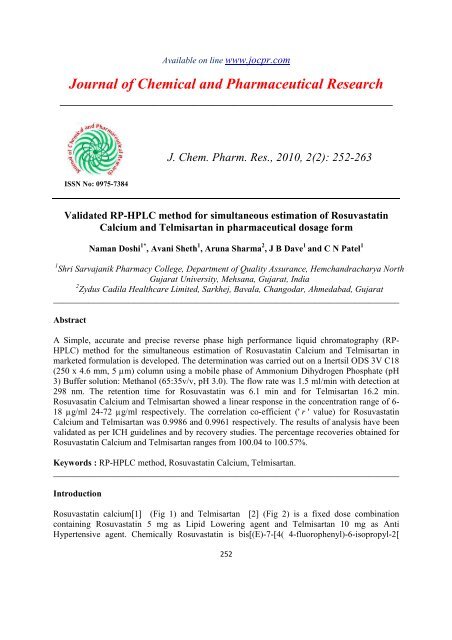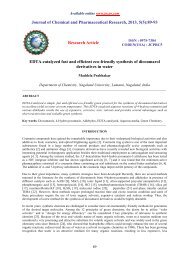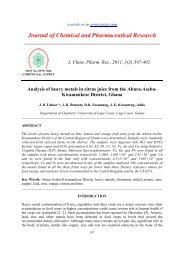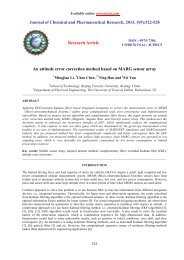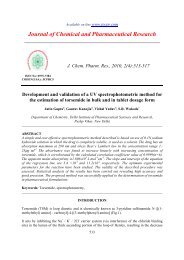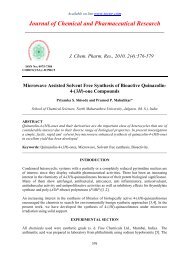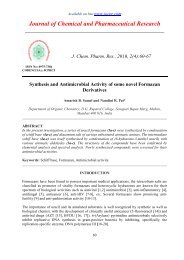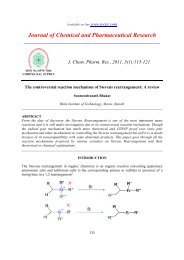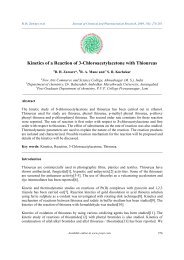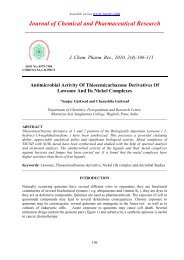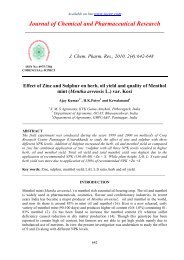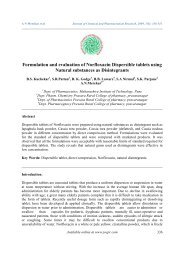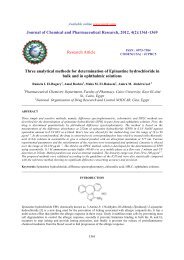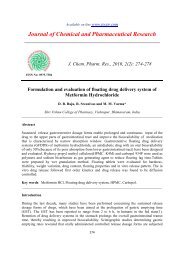Validated RP-HPLC method for simultaneous estimation of
Validated RP-HPLC method for simultaneous estimation of
Validated RP-HPLC method for simultaneous estimation of
- No tags were found...
You also want an ePaper? Increase the reach of your titles
YUMPU automatically turns print PDFs into web optimized ePapers that Google loves.
Available on line www.jocpr.comJournal <strong>of</strong> Chemical and Pharmaceutical Research__________________________________________________J. Chem. Pharm. Res., 2010, 2(2): 252-263ISSN No: 0975-7384<strong>Validated</strong> <strong>RP</strong>-<strong>HPLC</strong> <strong>method</strong> <strong>for</strong> <strong>simultaneous</strong> <strong>estimation</strong> <strong>of</strong> RosuvastatinCalcium and Telmisartan in pharmaceutical dosage <strong>for</strong>mNaman Doshi 1* , Avani Sheth 1 , Aruna Sharma 2 , J B Dave 1 and C N Patel 11 Shri Sarvajanik Pharmacy College, Department <strong>of</strong> Quality Assurance, Hemchandracharya NorthGujarat University, Mehsana, Gujarat, India2 Zydus Cadila Healthcare Limited, Sarkhej, Bavala, Changodar, Ahmedabad, Gujarat______________________________________________________________________________AbstractA Simple, accurate and precise reverse phase high per<strong>for</strong>mance liquid chromatography (<strong>RP</strong>-<strong>HPLC</strong>) <strong>method</strong> <strong>for</strong> the <strong>simultaneous</strong> <strong>estimation</strong> <strong>of</strong> Rosuvastatin Calcium and Telmisartan inmarketed <strong>for</strong>mulation is developed. The determination was carried out on a Inertsil ODS 3V C18(250 x 4.6 mm, 5 µm) column using a mobile phase <strong>of</strong> Ammonium Dihydrogen Phosphate (pH3) Buffer solution: Methanol (65:35v/v, pH 3.0). The flow rate was 1.5 ml/min with detection at298 nm. The retention time <strong>for</strong> Rosuvastatin was 6.1 min and <strong>for</strong> Telmisartan 16.2 min.Rosuvasatin Calcium and Telmisartan showed a linear response in the concentration range <strong>of</strong> 6-18 µg/ml 24-72 µg/ml respectively. The correlation co-efficient (' r ' value) <strong>for</strong> RosuvastatinCalcium and Telmisartan was 0.9986 and 0.9961 respectively. The results <strong>of</strong> analysis have beenvalidated as per ICH guidelines and by recovery studies. The percentage recoveries obtained <strong>for</strong>Rosuvastatin Calcium and Telmisartan ranges from 100.04 to 100.57%.Keywords : <strong>RP</strong>-<strong>HPLC</strong> <strong>method</strong>, Rosuvastatin Calcium, Telmisartan.______________________________________________________________________________IntroductionRosuvastatin calcium[1] (Fig 1) and Telmisartan [2] (Fig 2) is a fixed dose combinationcontaining Rosuvastatin 5 mg as Lipid Lowering agent and Telmisartan 10 mg as AntiHypertensive agent. Chemically Rosuvastatin is bis[(E)-7-[4( 4-fluorophenyl)-6-isopropyl-2[252
Naman Doshi et al J. Chem. Pharm. Res., 2010, 2(2): 252-263_____________________________________________________________________________methyl (methylsulfonyl) amino] pyrimidin-5-yl](3R,5S)3,5- dihydroxyhept-6-enoic acid]calcium salt. Chemically Telmisartan is 4'-[(1,4'-dimethyl-2'-propyl [2,6'-bi-1H-benzimidazol]-1'-yl)methyl]-[1,1'-biphenyl]-2-carboxylic acid. Pharmacologically Rosuvastatin Calcium is is alipid lowering agent. It is a competitive inhibitor <strong>of</strong> HMG-Co A reductase. It catalyses thereduction <strong>of</strong> 3-hydroxyl-3-methylglutaryl coenzymeA to mevalonate, which is a rate limitingstep in hepatic cholesterole synthesis. Mevalonate is a small molecule used in the synthesis <strong>of</strong>cholesterol and other mevalonate derivatives. In this way, it lowers the amount <strong>of</strong> cholesterol andLDL- cholesterol. Pharmacologically[3] Telmisartan interferes with the binding <strong>of</strong> angiotensin IIto the angiotensin II AT 1 -receptor by binding reversibly and selectively to the receptors invascular smooth muscle and the adrenal gland. As angiotensin II is a vasoconstrictor, which alsostimulates the synthesis and release <strong>of</strong> aldosterone, blockage <strong>of</strong> its effects results in decreases insystemic vascular resistance. Telmisartan does not inhibit the angiotensin converting enzyme,other hormone receptors, or ion channels. This is a new combination is market and so far noanalytical <strong>method</strong>s have been reported <strong>for</strong> <strong>simultaneous</strong> analysis <strong>of</strong> both the drugs together s<strong>of</strong>ollowing experiment was per<strong>for</strong>med.Fig 1 Rosuvastatin CalciumFig 2 TelmisartanExperimental Work & Condition: [4-6]-Materials Used:Rosuvastatin – Zydus CadilaHealthCare AnkleshwarTelmisartan - Hetro Drugs Ltd., India.Chemicals and Reagents:Diluent: Methanol (<strong>HPLC</strong> Grade) E. Merck (India) Ltd.,MumbaiMilli-Q Water: In-house production <strong>of</strong> company.Ortho-Phosphoric Acid: AR grade, Spectrochem. IndiaApparatus and EquipmentsAnalytical Balance:Metler ToledopH Meter: Thermo Orion, model 420Roop Telesonic Ultrasonix253
Naman Doshi et al J. Chem. Pharm. Res., 2010, 2(2): 252-263_____________________________________________________________________________<strong>HPLC</strong> SystemShimadzu LC 2010 HTChromatographic conditionColumn : Inertsil ODS 3V (250 X 4.6 mm), 5µDetector: 298 nmInjection Volume : 10 µlFlow Rate : 1.5 mL min -1Temperature : 40º CRun Time : 20 minutesMobile Phase : Buffer: Methanol (65:35)Diluent: MethanolMarketed Preparation:Rosatel Tab. (Rosuvastatin Calcium and Telmisartan Tablets 10 mg + 40 mg, were procuredfrom Zydus CadilaHealthcare Ltd.)Materials and MethodsExperimentalMaterial usedTelmisartan, Active Pharmaceutical Ingredient (API) and working standard was supplied byCadila Healthcare Limited (Ankleshwar, India). Rosuvastatin Calcium, Active PharmaceuticalIngredient (API) and working standard was supplied by Dr. Reddy Laboratory (Hyderabad, India)Combination drug product <strong>of</strong> Telmisartan and Rosuvastatin Calcium was provide by Zydus CadilaHealthcare Limited (Ahmedabad, India)Buffer preparationAccurately weighed 4 g Ammonium Dihydrogen Phosphate was dissolved in to 2000 mL Milli-Q water and pH was adjusted to 3.0 with ortho-phosphoric acid[1-2].Preparation <strong>of</strong> standard solutionThe standard stock solution Rosuvastatin Calcium (200ppm) and Telmisartan (200ppm)respaectively were prepared in 100ml volumetric flask with methanol. Then each 3ml solutionwere diluted in 50ml volumetric flask to make final standard concentration <strong>of</strong> RosuvastatinCalcium and Telmisartan 12 ppm and 48 ppm respectively[3-4].Preparation <strong>of</strong> test solutionAccurately 20 intact tablets were weighed and average weight <strong>of</strong> tablet was calculated. Thentablets were finely crushed and 1335.5 mg powder <strong>of</strong> tablets equivalent to 10 mg Rosuvastatinand 40 mg Telmisartan and transferred into 100 ml volumetric flask. Then add about 50.0 mldiluent was added and sonicate <strong>for</strong> 40 minutes with intermittent shaking. Filtered it through0.45µ (PVDF Millipore Filter).This solution was diluted to make final concentration <strong>of</strong> testsolution 12 ppm Rosuvastatin Calcium and 48 ppm Telmisartan[5-6].254
Naman Doshi et al J. Chem. Pharm. Res., 2010, 2(2): 252-263_____________________________________________________________________________Result and discussionLiterature review reveals only individual <strong>method</strong>s <strong>for</strong> <strong>estimation</strong> <strong>of</strong> Rosuvastatin Calcium andTelmisartan but no <strong>method</strong>s were reported <strong>for</strong> <strong>simultaneous</strong> <strong>estimation</strong> <strong>of</strong> Rosuvastatin Calciumand Telmisartan. So <strong>method</strong> was developed <strong>method</strong> more superior than previously published<strong>method</strong>s <strong>of</strong> individual <strong>estimation</strong> <strong>of</strong> both drugs.. The composition <strong>of</strong> mobile phase is adjusted tomaintain highly accurate and specific results. The detection wavelength <strong>of</strong> 298nm was chosen inorder to achieve a good sensitivity <strong>for</strong> quantitative determination <strong>of</strong> Rosuvastatin Calcium andTelmisartan in solid dosage <strong>for</strong>m. The chromatographic separation <strong>of</strong> Rosuvastatin andTelmisartan in the present combination is shown in figure and separation <strong>of</strong> active ingradients.The compounds eluted in the order <strong>of</strong> Rosuvastatin Calcium and Telmisartan with retention time<strong>of</strong> 5.7 min and 16.2 min respectively. The isocratic program throughout <strong>HPLC</strong> <strong>method</strong> wasadopted to analyze two components in a single run[7-8].Method ValidationValidation was carried out with respect to various parameters, as required under ICH guidelineQ2 (R1).[21] The developed <strong>method</strong> validated with respect to parameters such as linearity,precision, accuracy, specificity, ruggedness, robustness and solution stability[9].System suitability and system precisionSystem suitability and system precision was daily per<strong>for</strong>med during entire validation <strong>of</strong> this<strong>method</strong>. The results <strong>of</strong> system suitability and system precision were presented.Table 1. General Parameters <strong>for</strong> <strong>of</strong> <strong>RP</strong> <strong>HPLC</strong> AnalysisCompound Retention Time N R T K’Rosuvastatin Calcium 5.7± 0.0022 4335.33 0.0 1.07 153.4Telmisartan 16.2 ± 0.0029 8660.77 27.3 0.99 33.90N= Theoretical plates; R= Resolution; T= Assymetry, K’= Capacity Factor.255
Naman Doshi et al J. Chem. Pharm. Res., 2010, 2(2): 252-263_____________________________________________________________________________LinearityTo achieve linearity and range, stock solution containing 0.200 mg mL -1 Rosuvastatin Calciumand 0.200 mg mL -1 Telmisartan were diluted to yield solution in the concentration range <strong>of</strong> µgmL -1 and 24-72 µg mL -1 <strong>for</strong> Rosuvastatin Calcium and Telmisartan respectively. The solutionswere analyzed by using 10µl into <strong>HPLC</strong>. The results were presented in Table 2.Sr. No.Parameters(n=5)Table 2: Results <strong>of</strong> LinearityRosuvastatinTelmisartan1 Retention Time (min) 5.7 16.22 Theoritical Plates 7872 8286.413 Asymmetry 1.01 1.024 Capacity Factor 151.17 75.175 % RSD 0.2 0.16 Linearity range 0.528 - 18 µg/ml 1.056 – 72 µg ml7 Linearity equation y = 5039.3 x + 10150 y = 21659 x + 136038 Correlation coefficient 0.9991 0.99869 LOD 0.6 µg/ml 2.4 µg/ml10 LOQ 1.8 µg/ml 7.2 µg/mlLinearityRangeTable 3: Linearity Data <strong>of</strong> RosuvastatinStock solution to betaken in mlDilute to volume(ml)with diluentFinalconcentration inµg/mlRosuvastatinArea50% 1.50 50 6 4004475% 2.25 50 9 54665100% 3.00 50 12 71174125% 3.75 50 15 84516150% 4.50 50 18 100708256
Naman Doshi et al J. Chem. Pharm. Res., 2010, 2(2): 252-263_____________________________________________________________________________Table 4: Linearity Data <strong>of</strong> TelmisartanLinearityRangeStock solution to betaken in mlDilute to volume (ml)with diluentFinal concentrationin µg/mlTelmisartanArea50% 1.50 50 24 51738675% 2.25 50 36 808009100% 3.00 50 48 1056145125% 3.75 50 60 1327477150% 4.50 50 72 1557204Fig 3 Linearity Chromatograms <strong>for</strong> Rosuvastatin Calcium and TelmisartanFig 4 Linearity and calibration curve.Rosuvastatin CalciumTelmisartan257
Naman Doshi et al J. Chem. Pharm. Res., 2010, 2(2): 252-263_____________________________________________________________________________Precision[10]The <strong>method</strong> precision was done by preparing six different sample preparations by one analystunder the same condition. The results were presented in Table 3. The results obtained were within2% RSD.RuggednessRuggedness test was determined between two different analysts, instruments and Columns. Thevalue <strong>of</strong> percentage RSD was below 2.0%, showed ruggedness[11] <strong>of</strong> developed analytical<strong>method</strong>. The results were presented in Table 5.Table 5: Results <strong>of</strong> Method Precision and RuggednessParametersTelmisartan%AssayMean (n=6)Rosuvastatin Calcium% RSD %AssayMean (n=6)% RSDMethod Precision 99.87 1.2 100.04 0.4Ruggedness 100.01 0.8 100.03 1.3AccuracyThe difference between theoretical added amount and practically achieved amount is calledaccuracy <strong>of</strong> analytical <strong>method</strong>. Accuracy[12] was determined at three different level 50%, 100%and 150% <strong>of</strong> the target concentration in triplicate. The results were presented in Table 4.Results <strong>of</strong> Accuracy Data <strong>of</strong> RosuvastatinTable 6: Results <strong>of</strong> accuracyFor Rosuvastatin CalciumLevel50 %100 %150 %Amount <strong>of</strong>Drug added(mg )Amount <strong>of</strong> Drugrecovered(mg)52.30 53.44 102.252.50 52.97 100.352.40 52.64 100.5104.80 105.54 100.7104.20 105.12 100.9104.80 105.53 100.7156.30 156.70 100.3156.10 156.19 100.1156.30 156.18 99.9258Recovery (%) Mean % RSD100.3 0.2100.7 0.1100.1 0.2
Naman Doshi et al J. Chem. Pharm. Res., 2010, 2(2): 252-263_____________________________________________________________________________Table 7: Results <strong>of</strong> Accuracy Data <strong>of</strong> TelmisartanFor TelmisartanLevel50 %100 %150 %Amount <strong>of</strong>Drug added(mg)Amount <strong>of</strong> Drugrecovered(mg)75.50 76.53 101.474.50 74.22 99.675.20 75.69 100.6150.40 151.68 100.9149.50 150.35 100.6150.0 151.04 100.7224.80 223.64 99.5225.50 225.74 100.1216.00 219.22 101.5Recovery (%) Mean % RSD100.3 0.3100.8 0.2100.2 0.1Fig. 5 Overlay chromatogram <strong>of</strong> Placebo, standard, Mobile and Diluent in specificity study.Solution stability[13-14]:The standard and sample solutions were found stable up to 24 hours at room temperature. After4, 8, 12, 16, 20, 24 hours the solutions were analysed. No significant changes (
Naman Doshi et al J. Chem. Pharm. Res., 2010, 2(2): 252-263_____________________________________________________________________________Table 8: Results <strong>of</strong> standard and solution stabilityTime(hour)Area% DifferenceRosuvastatin Telmisartan Rosuvastatin Telmisartan0 (Initial) 70337 1057672 == ==4 70084 1057215 -0.4 0.18 70298 1057197 -0.3 0.112 70099 1058281 -0.6 0.116 70467 1055380 0.2 -0.220 71010 1058984 0.7 0.224 71064 1059635 1.1 0.4% Mean RSD 0.17 0.18Table 9: Results <strong>of</strong> Sample Solution StabilityTime(hour)Area% DifferenceRosuvastatin Telmisartan Rosuvastatin Telmisartan0 (initial) 70893 1058772 == ==4 70356 1067215 -0.2 0.48 70265 1077187 -0.3 0.612 71230 1078282 0.5 0.916 71567 1075481 0.7 0.820 71310 1078984 0.6 1.224 71069 1079635 0.7 1.3% Mean RSD 0.33 0.86RobustnessRobustness[15-16] <strong>of</strong> the <strong>method</strong> was carried out by deliberately made small change in the flowrate, pH, organic phase ratio and column oven temperature[17-19]. Results were presented inTable 9.260
Naman Doshi et al J. Chem. Pharm. Res., 2010, 2(2): 252-263_____________________________________________________________________________Table 10: Results <strong>of</strong> Robustness studyRosuvastatin Calcium Robustness StudySys. Temp. Temp. Flow - Flow Org. - Org. pH = pH =Sr. NoSuit. -5°C +5°C 10% +10% 2% +2% 3.2 2.81 69342 69784 69847 69652 70289 69265 69265 70693 707542 69469 68497 68702 69525 70382 68700 69700 70599 706553 69181 69942 69087 69039 70635 69710 68721 70318 702564 69219 69191 68582 69869 70174 69110 69110 70289 702315 69281 69967 70384 69857 70085 70467 68467 70618 70523%RSD 0.3 0.7 1.0 0.3 0.5 1.1 0.4 0.4 0.6Table 11: Results <strong>of</strong> Robustness StudyTelmisartan Robustness StudySr.NoSys.Suit.Temp.-5°CTemp.+5°CFlow-10%Flow+10%Org. -2%Org.+2%pH = 3.2 pH = 2.81 1057672 1053621 1036265 1036352 1045623 1035264 1032643 1032654 10315262 1057215 1056234 1031564 1032563 1032652 1032652 1032652 1032646 10562343 1057197 1035621 1032162 1032562 1032642 1032645 1065231 1065895 10326544 1058281 1034536 1035623 1032546 1032654 1032654 1032156 1032263 10546525 1055380 1023562 1032561 1032564 1032655 1035624 1032642 1031361 1053552%RSD 0.2 0.3 0.5 0.4 0.6 0.7 0.9 1.1 0.9Table 12: Summary <strong>of</strong> Validation Parameters <strong>of</strong> <strong>RP</strong> <strong>HPLC</strong> Method <strong>for</strong> Simultaneous<strong>estimation</strong> <strong>of</strong> Rosuvastatin Calcium and TelmisartanParameter Acceptance Crieteria Rosuvasatin Calcium TelmisartanRange <strong>of</strong> LinearityCorrelationCoefficientCorrelation coefficient r 2 > 0.999 or 0.9950.528 - 18 µg/ml0.99911.056 – 72 µg ml0.9986LOD S/N > 2 or 3 0.6 µg/ml 2.4 µg/mlLOQ S/N > 10 1.8 µg/ml 7.2 µg/mlPrecision RSD < 2% %RSD = 0.4 %RSD = 1.2Intermediate RSD < 2% %RSD = 1.3 % RSD =0.8PrecisionAccuracy Recovery 98- 102% (individual) % recovery= 100.5 % recovery = 100.6Specificity1) No intereference from blank, placeboand other degradation products with themain peak.2) The peak purity index > 0.999No intereference.Peak purity1)Test sample= 0.99922)Spiked sample= 0.9998Solution Stability > 12 hour Stable up to 24 hour%RSD = 0.3No intereference.Peak purity1)Test sample= 0.99982) Spiked sample= 0.9998Stable up to 24 hour%RSD = 0.8Robustness RSD NMT 2% in modified condition Complies Complies261
Naman Doshi et al J. Chem. Pharm. Res., 2010, 2(2): 252-263_____________________________________________________________________________ConclusionThus proposed <strong>method</strong> was found to be simple, accurate, precise selective and economical <strong>for</strong><strong>simultaneous</strong> routine analysis <strong>of</strong> Rosuvastatin Calcium and Telmisartan in tablet dosage <strong>for</strong>mAcknowledgmentsThe authors are grateful to Zydus Cadila Healthcare Limited <strong>for</strong> the providing samples and allother facilities to complete the entire project.References[1] BK Sharma. Instrumental <strong>method</strong>s <strong>of</strong> chemical analysis, In; Introduction to Analyticalchemistry, 23rd Edition, Goel Publishing House, Meerut, 2004; 1-4.[2] Willard HH, Merritt LL, Dean JJA, Frank AS. Instrumental <strong>method</strong> <strong>of</strong> analysis. 7th Edition,CBS Publishers and Distributors, New Delhi, 1986; 321-23.[3] Higuchi T, Brochman−Hausen E. Pharmaceutical Analysis. 6th Edition, Interscience, London, 1961;433-40.[4] Siggia S, Hanna JG. Quantitative organic Analysis via Functional Groups. 4th Edition,Interscience, Nottingholm, 1979; 231-35.[5] Michael E, Schartz IS, Krull. Analytical <strong>method</strong> development and Validation. 2004; 25-46.[6] Berry RI, Nash AR. Pharmaceutical Process Validation; Analytical <strong>method</strong> validation.Marcel Dekker Inc, New work, 1993, 57, 411-28.[7] Elhance DN. Foundation <strong>of</strong> statistics. Kitab mahal, Cheronics ND, Ma TS. OrganicFunctional Group Analysis by Micro and Semi micro Methods. 47th Edition, Interscience, NewYork, 1964, 20, 229.[8] Hunig S, Balli H, Briether E, Bruhne F, Geiger H, Grigat E, Muller F, Quast H. AngewChem. 1962, 74, 818-24.[9] Sawicki E, Hauser TR., Stanley TW, Elbert W. Anal Chem. 1961, 33, 93-94[10] AS Jadhav; DB Pathare; MS Shingare. Journal <strong>of</strong> Pharmaceutical and Biomedical Analysis,2007, 43(4), 1568-1572.[11] P Musmade; G Subramanian; KK Srinivasan. Analytica Chimica Acta, 2007, 585(1), 103-109.[12] SL Prabu; T Singh; A Joseph; C Dinesh Kumar; A Shirwaikar. Indian Journal <strong>of</strong>Pharmaceutical Sciences, 2007, 69(6), 819-821.[13] BS Sastry; D Srinivasulu; H Ramana. Journal <strong>of</strong> Pharmaceutical Research and HealthCare, 2009, 1(1), 25-33.[14] RT Sane; S Menon; AY Deshpande; A Jain. Chromatographia, 2005, 61(3-4), 137-141.[15] M Yadav; V Upadhyay; P Singhal; S Goswami; PS Shrivastav. Journal <strong>of</strong> ChromatographyB, 2009, 877(8-9), 680-688.[16] W Kang; EY Kim. Journal <strong>of</strong> Pharmaceutical and Biomedical Analysis, 2008, 46(3), 587-591.[17] Y Xu; J Huang; F Liu; S Gao; Q Guo. Journal <strong>of</strong> Chromatography B, 2007, 852(1-2), 101-107.[18] NVS Ramakrishna; KN Vishwottam; M Koteshwara; S Manoj; M Santosh; DP Varma.Journal <strong>of</strong> Pharmaceutical and Biomedical Analysis, 2005, 39(5), 1006-1013.262
Naman Doshi et al J. Chem. Pharm. Res., 2010, 2(2): 252-263_____________________________________________________________________________[19] P Turnpenny; D Fraie. Journal <strong>of</strong> Pharmaceutical & Biomedical analysis, 2009, 49(1), 133-139.263


